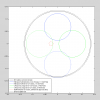I've taken a look at guardian state information from the last week, with the goal of getting an idea of what we can do to improve our duty cycle. The main messages is that we spent 63% of our time in the nominal low noise state, 13% in the down state, (mostly because the DOWN state was requested), and 8.7% of the week trying to lock DRMI.
Details
I have not taken into account if the intent bit was set or not during this time, I'm only considering the guardian state. These are based on 7 days of data, starting at 19:24:48 UTC on June3rd. The first pie chart shows the percentage of the time during the week the guardian was in a certain state. For legibility states that took up less than 1% of the week are unlabeled, some of the labels are slightly in the wrong position but you can figure out where they should be if you care. The first two charts show the percentage of the time during the week we were in a particular state, the second chart shows only the unlocked time.
DOWN as the requested state
We were requesting DOWN for 12.13% of the week, or 20.4 hours. Down could be the requested state because operators were doing initial alignment, we were in the middle of maintainece (4 hours ), or it was too windy for locking. Although I haven't done any careful study, I would guess that most of this time was spent on inital alingment.
There are probably three ways to reduce the time spent on initial alignment:
-
reducing the number of times that we do initial alignment. We don't really know how often we need to be doing this, and we might be able to do some offloading in full lock before powering up and see if that gives us an alignment that is good for lock acquisition.
-
There are a few improvements to the ALIGN_IFO guardian that might help a little.
-
Last, as the operators get more experience with the alignment procedure it should become faster.
Bounce and roll mode damping
We spent 5.3% of the week waiting in states between lock DRMI and LSC FF, when the state was already the requested state. Most of this was after RF DARM, and is probably because people were trying to damp bounce and roll or waiting for them to damp. A more careful study of how well we can tolerate these modes being rung up will tell us it is really necessary to wait, and better automation using the monitors can probably help us damp them more efficiently.
Locking DRMI
we spent 8.7% of the week locking DRMI, 14.6 hours. During this time we made 109 attempts to lock it, (10 of these ended in ALS locklosses), and the median time per lock attempt was 5.4 minutes. From the histogram of time for DRMI locking attempts(3rd attachment), you can see that the mean locking time is increased by 6 attempts that took more than a half hour, presumably either because DRMI was not well aligned or because the wind was high. It is probably worth checking if these were really due to wind or something else. This histogram includes unsuccessful as well as successful attempts.
Probably the most effective way to reduce the time we spend locking DRMI would be to prevent locklosses later in the lock acquisition sequence, which we have had many of this week.
Locklosses
A more careful study of locklosses during ER7 needs to be done. The last plot attached here shows from which guardian state we lost lock, they are fairly well distributed throughout the lock acquisition process. The locklosses from states after DRMI has locked are more costly to us, while locklosses from the state "locking arms green" don't cost us much time and are expect as the optics swing after a lockloss.





















